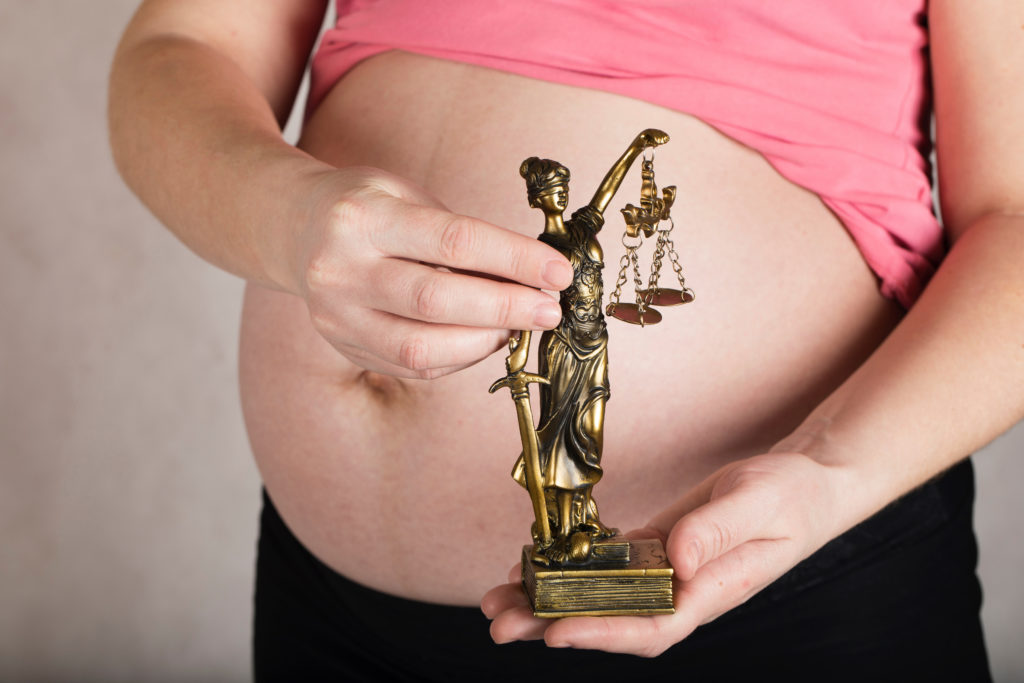Surrogacy is an agreed arrangement in which a woman commits to carrying and birthing another person or couple’s child. The process is facilitated by new and emerging technologies that offer intending parents the opportunity to have biological children despite existing complications. While surrogacy and other assisted reproductive technologies (ART) provide tangible benefits, they also present novel ethical challenges for policymakers and legislators.

Types of surrogacy arrangements
Surrogacy arrangements can be distinguished in two ways. These include:
Traditional surrogacy
In traditional surrogacy, both the egg and the womb of the surrogate mother are used, making the surrogate mother the genetic mother of the child. The sperm is either provided by the intending parent or through a sperm donor (McLatchie et al., 2022).
Gestational surrogacy
In gestational surrogacy, the surrogate mother carries the child, but the gametes that are used are not her own, she does not have any genetic link to the surrogate-born child. The surrogate mother becomes pregnant through the process of in vitro fertilization (IVF) using an egg and sperm from either the intending parents or a donor (McLatchie et al., 2022).
Types of surrogacy agreements
There are two types of surrogacy agreements, these include: (McLatchie et al., 2022)
Altruistic surrogacy
Altruistic surrogacy is an agreement whereby the surrogate mother gives the child to the intending parents without receiving any financial payment. However, pregnancy-related expenses are taken care of by the intending parents. This type of surrogacy agreement is common amongst family and friends.
Commercial surrogacy
Commercial surrogacy is an agreement in which both the surrogate mother and the intending parents enter a commercial contract for profit that financially renumerates the surrogate mother beyond ‘reasonable expenses.’ The compensation details are pre-arranged, and it is agreed that the intending parents will cover all the medical, legal, travel expenses, as well as other expenses that arise during the surrogacy process.
The cross-border elements of surrogacy agreements are diverse. Most often, intending parents from ‘developed’ countries such as Canada, the United Kingdom, Australia, Spain, Norway, Italy, Germany, France, Israel, Ireland and the United States of America, travel to ‘developing’ countries such as Cambodia, Thailand, Nepal, India, Ukraine, Georgia, Russia and China to commission surrogate mothers (UN General Assembly, 2018). Intending parents often seek surrogate mothers in developing countries due to less restrictive laws to regulate surrogacy, lower costs than in developed countries, higher availability or willing surrogate mothers, socioeconomic factors, and the legal recognition of parental rights.
Claiming parental rights
Within a surrogacy arrangement, there are up to six (sometimes more) who can claim parental rights over the surrogate-born child. These include:
Intending parents
Also referred to as ‘commissioning parents.’ The person(s) who commissions a surrogate mother with the intent to carry their child and for them to be legally recognized as the parents of the child. The intending parents may or may not be genetically related to the child (McLatchie et al., 2022).
Surrogate mother
The woman who has agreed to carry the child (or children) in her womb on behalf of the intending parents and she relinquishes her parental rights once the child is born (McLatchie et a.l, 2022).
Gamete donor
The woman or man who has donated their gametes to conceive a child. The anonymity of gamete donors varies in different countries (McLatchie et al., 2022).
Legal father
If the surrogate mother is married, in many legal systems, her husband is the ‘legal father’ of the surrogate-born child (McLatchie et al., 2022).
International human rights law and surrogacy

Children born through surrogacy hold the same fundamental human rights as all children under the United Nations Convention on the Rights of the Child (CRC). Consequently, all countries hold an obligation to protect children born through surrogacy, even if the practice is prohibited. State responsibilities include developing and maintaining functional regulatory frameworks to protect children from harm (UNICEF, 2022).
Article 35 of the CRC urges countries to “take all appropriate national, bilateral and multilateral measures to prevent the abduction of the sale of or traffic in children for any purpose or in any form.” The definition’s breadth encapsulates surrogacy, and the act further outlines the need to ensure families are not formed through “the abduction or the sale of or traffic in children”. This position is supported by the Committee on the Rights of the Child’s review of states affected by surrogacy, which states that surrogacy can constitute the unlawful sale of children if not regulated.
Beyond the CRC, the 1993 Hague Convention on Protection of Children and Cooperation in respect of Intercountry Adoption also validates the application of the CRC’s provisions to surrogacy and alternative forms of family formation.
Both conventions note and recognise acceptable differences in national laws related to intercountry adoption – which is a natural byproduct of surrogacy arrangements. However, a state’s position on the legality of surrogacy and intercountry adoption does not preclude them from requirements to implement safeguards to protect children from being forced into families through abduction, sale or trafficking (UN General Assembly, 2018).
Domestic surrogacy laws
Domestic surrogacy laws exist on a spectrum and can be regulated at the national or regional level. In the most prohibitive contexts, countries – such as Germany and France – outlaw surrogacy in all its forms. In median cases – such as the United Kingdom, Australia, and South Africa, among others – countries outlaw commercial or for-profit surrogacy. In the most liberal cases – such as Cambodia, India, Nepal, and Thailand – countries permit commercial surrogacy for national and foreign intending parents, creating de facto centres for commercial international surrogacy.
Recent years have seen a gradual, general decline in the most liberal surrogacy approaches, with countries taking steps to limit abusive practices and enhance stricter monitoring, given the existing vast discrepancy in the comprehensiveness of national laws (UN General Assembly, 2018).
Perhaps the most alarming contexts are those in which surrogacy remains wholly or partially unregulated. In Argentina, Belgium, and Japan, among other countries, there is no legislation on surrogacy, forcing courts to develop their own precedents based on existing analogous legislation. In these settings, domestic laws on termination of parental rights and adoption are read in line with foundational human rights documents to develop new practice (UN General Assembly, 2018)
Verona Principles
In 2013, the International Social Service (ISS), called for urgent international regulation for surrogacy and surrogate-born children. In this context, the ISS drafted the Verona Principles to provide international guidance for upholding the rights of the surrogate-born child.
The principles are inspired by the UNCRC, the Optional Protocol on the Sale of Children, Child Prostitution and Child Pornography and other relevant human rights instruments which do not provide any guidance or address surrogacy explicitly. The Verona Principles provide guidance on the adequate need to protect children born through surrogacy (ISS, 2021).
Challenges for children born through surrogacy arrangements
Surrogate-born children are at risk of numerous human rights violations, including their right to a name, nationality and identity, the right to family relation and access to their origins, the right to health and the right not to be sold. Beyond these and other broader risks, surrogacy also carries with it a specific set of potential rights violations, including:
Establishment of legal parentage
In surrogacy arrangements, up to six or more people can claim parental rights over the surrogate-born child. While it is in the best interests of the child to have legal parentage established soon after birth, it is important that pre-surrogacy safeguards are taken, consent sought from all parties involved in the arrangement, and the child provided with access to their origins. Legal parentage should not be established for remuneration, and the rights of the child should not be compromised prior to the birth of the child, even in unforeseen circumstances (UNICEF & Child Identity Protection, 2022).
Landmark cases in relation to legal parentage
This principle is evidenced in several landmark cases. In the case of Foulon and Bouvet v France, French authorities refused to accept birth certificates as evidence of parenthood for two independent French fathers who had children born in India under surrogacy agreements.
This was tied to Articles 16 and 17 of the French Civil Code, which prohibits international surrogacy arrangements of this kind. Upon receiving the case, the European Court of Human Rights (ECHR) relied on precedents in its ruling that the children had experienced a violation of their Article 8 (European Convention on Human Rights) right to respect for family life, irrespective of France’s domestic legislation.
France was instructed to transcribe and validate the birth certificates, ensuring domestic parenthood rights were acknowledged. The case reaffirms the validity of international children’s rights law over domestic provisions and, in particular, demonstrated the applicability of this principle to same-sex families (Human Rights Law Centre, 2016).
Similarly, in the Case of Paradiso and Campanelli v Italy, two Italian nationals entered into a surrogacy agreement with a woman in Russia to conceive and birth, via IVF, a child who was attested by all parties to be the genetic child of the applicants. The child’s Russian birth certificate failed to communicate the surrogacy arrangement or the fact that the child was not genetically related to either parent.
As a result, the Italian authorities failed to recognise the birth certificate and ordered the child to be placed under the alternative guardianship of the country’s social services. Following a sustained court process, the ECHR compelled the authorities to create a new birth certificate that correctly distinguished the de facto parents from the biological ones, ensuring the child could remain with their parents without approving inaccurate documentation. The case demonstrates the lengths the ECHR will go to to ensure children remain with their standing parents (CRIN, 2015).
Statelessness
The lack of regulation surrounding cross-border surrogacy often leaves children born through surrogacy in limbo regarding citizenship. This is due to the complexities of establishing legal parentage tied to nationality laws both in the country of birth or the country of origin of the intending parents. In extreme cases, surrogate-born children can be left stateless, without citizenship to any jurisdiction.
Citizenship rights are a fundamental precursor to other national rights and provisions. Without them, children risk being denied access to social services (such as health, education, and financial benefits) and other national benefits. Citizenship issues arise when the country of origin of the intending parents or the country of birth does not legally recognise surrogate-born children (Batha, 2014). The complexities of this challenge are evidenced in recent case law.
Landmark cases in relation to statelessness
In the 2019 case of C. v. Italy, a child was born through surrogacy in Ukraine using a donor egg and sperm from the intending father, implanted into the surrogate mother. Both intending parents originated from Italy. Once the child was born in Ukraine, the Ukrainian authorities issued a birth certificate, which the intending parents took to Italy and requested that the details of the Ukrainian birth certificate be entered into the Italian registry. However, the Italian authorities rejected this on the grounds that surrogacy is prohibited under Italian law (European Court of Human Rights, 2023).
The case of C. v. Italy demonstrates a breach of the right to private family life by denying the legal establishment of a parent-child relationship between the surrogate-born child and her biological father and intended mother. The Italian government argued that in accordance with Article 8 of the ECHR, the government could not transcribe a foreign birth certificate for a child born through surrogacy.
The Italian government further stated that under the Civil Code, the intended and biological father of the child would be recognised, granting the surrogate-born child Italian nationality. However, the intended mother would be required to legally adopt the surrogate-born child (European Court of Human Rights, 2023).
Contrastingly, in the case of Mennesson v France, the intending parents commissioned a surrogate mother in California using a donor egg and the intending father’s sperm. Following the birth of the Mennesson twins, French authorities did not legally recognize the parent-child relationship, and as a result, the intending parents were unable to share their French nationality.
In 2014, when the case reached the European Court of Human Rights, the court found that France had violated Article 8 of the European Convention on Human Rights. Following the judgement of the Menneson case, France made it possible for surrogate-born children who are born abroad to obtain a birth certificate (Weiss, 2020).
Child’s right to establishment and preservation of identity
The CRC provides all children with the right to a name and nationality at birth. It also urges states to ensure children can be cared for by their parents, and to consider alternative family arrangements only as a last resort. Up to six adults can claim parental rights towards children born through surrogacy: the intending or commissioning parents, the biological parents or gamete donors, and the legal parents.
By definition, this means that surrogate-born children are unlikely to be able to realise the full breadth of a potential relationship with their parents, as each party holds a different link to the child. As a result, and to ensure stability, countries will often annex certain parties from a child’s life to ensure a cohesive identity (McLatchie et al., 2022).
This approach is not without its challenges. Separating children from their biological parents may rob them of the opportunity to experience and understand their genetic lineage. Similarly, registering surrogate-born children as if they were born to intending parents may block them from accessing crucial social and medical information tied to their biological or legal parents.
These challenges have led countries to implement bespoke laws and policies – as well as unwritten precedents – to determine which surrogacy contracts are acceptable. Where countries disagree over the validity of a surrogacy contract, children risk being rendered stateless, ridding them of a key component of their identity (McLatchie, 2022).
Commodification of the surrogate-born child
The lack of domestic and international regulations surrounding surrogacy has led to the development of a commercial market for the sale and trafficking of surrogate children. Commercial surrogacy arrangements typically mandate that the transfer of the child to the intending parents is contingent upon payment or remuneration.
Children are the commodity in this sale. The opaqueness of these market risks goes against CEF guidelines, which state that ‘the identity and family relations of a child cannot be for sale’ (UNICEF and Child Identity Protection, 2022).
The challenge for regulators is how to maintain the best interests of the child (Article 3, CRC) via a process that inherently puts them in a vulnerable position. Countries have experienced a loophole: they must allow surrogate mothers to receive financial payments as it is in the best interests of the child for their mother to be happy, healthy, and have routine medical support. This enables commercial surrogacy agreements to be coupled with abusive practices as intending parents take advantage of surrogate mothers (United Nations General Assembly, 2019).
Selective creation of the child
The process of surrogacy can build atypical and unusual perceptions of children. If commissioning parents are perceived as ‘purchasing’ a child, this transaction may come with expectations that skew how children are perceived and treated. More complex processes – such as IVF – also open the door for gene selection.
This has seen parents try to ‘craft’ or manipulate children’s genetic makeup to bias them towards certain features. This can lead to severe and dangerous outcomes for children: in the 2013 Gammy case, two Australian commissioning parents refused to accept one of their twins born to a surrogate mother in Thailand because one of them had Down Syndrome. (McLatchie et al., 2022).
Further case law reaffirms the dangers of curating children’s characteristics. In 2019, an American couple commissioned a surrogate mother in Ukraine. Soon after, Bridget Irmgard Pagan-Etnyre, the surrogate-born child, was abandoned after they discovered that she was born with disabilities. Aside from the actions of children’s parents, regulators can also perpetuate dangerous narratives about the process of creating a child.
In the Cook v Harding case, a commissioning father tried to force a surrogate mother to have an abortion owing to the unexpected news that she was pregnant with triplets. National legal provisions meant the surrogate mother would be liable to pay monetary damages and medical costs for the child if she chose not to proceed with the abortion (UN General Assembly, 2018).
Protecting children’s rights in surrogacy arrangements
The rapid speed of technological advancement in this area is not mirrored appropriately by corresponding legal and policy responses. This has birthed an alarming regulatory vacuum and exposed children to a myriad of risks. Without a comprehensive and enforceable legislative framework, children can be subjected to decisions without having their best interests considered. In the most severe cases, the high demand for surrogacy can lead to a market for the unregulated sale of children (UNHCR, n.d).

Addressing violations of children’s rights for surrogate-born children requires comprehensive solutions that prioritize the well-being of children. These include (Achmad, 2018):
- Establishing clear national and international legal frameworks: ensuring that both international and national legal frameworks are consistent in the protection of children’s rights; ensuring that legal parentage is established at birth and that the birth of the surrogate-born child is registered promptly and accurately; ensuring that mechanisms are in place to prevent statelessness.
- Ethical standards and guidelines: surrogacy guidelines must be centred on ethical rather than practical considerations, noting the dramatic impact a child’s surrounding environment and carers can have on their development and the burden associated with pregnancy and childbirth.
- A focus on upholding the rights of the child: the best interest of the child should be paramount in all surrogacy considerations, ensuring children are not an afterthought in decision-making processes.
- Closer regulation and scrutiny of commercial surrogacy arrangements: Noting the vulnerability of children in commercial surrogacy agreements and differences between jurisdictional legislation and policy on the matter, international bodies and adjudicators must closely monitor children’s rights to ensure they are protected.
Written by Vanessa Cezarita Cordeiro
Internally proofread by Aditi Partha
Last updated on 30 June 2024
References:
Achmad, C.I. (2018, June 26). “Children’s rights in international commercial surrogacy: exploring the challenges from a child rights, public international human rights law perspective.” Retrieved from Leiden University Repository, accessed on 15 June 2024.
Batha, E. (2014, September 18). “International surrogacy traps babies in stateless limbo.” Retrieved from Reuters, accessed on 20 June 2024.
CRIN. (2015, January 27). “Paradiso and Campanelli v. Italy.” Retrieved from Child Rights International Network, accessed on 28 June 2024.
European Court of Human Rights. (2023, August 31). “C. v. Italy application no. 47196/21.” Retrieved from Statelessness Case Law Database, 20 June 2024.
Human Rights Law Centre. (2016, July 21). “ECHR finds failure to recognize parents of children born as a result of international commercial surrogacy violates the right to privacy.” Retrieved from Human Rights Law Centre, accessed on 28 June 2024.
International Social Service. (2021). “Principles for the protection of the rights of the child born through surrogacy (Verona Principles).” Retrieved from International Social Service, accessed on 22 June 2024.
McLatchie, L. & Lea, J. (2022). “Surrogacy, law and human rights.” Retrieved from ADF International White Paper, accessed on15 June 2024.
UN General Assembly. (2018, January 15). “Report of the Special Rapporteur on the sale and sexual exploitation of children, including child prostitution, child pornography and other child sexual abuse material.” Retrieved from UN General Assembly, accessed on 22 June 2024.
UN General Assembly. (2019, July 15). “Sale and sexual exploitation of children, including child prostitution, child pornography and other child sexual abuse material.” Retrieved from UN General Assembly, accessed on 22 June 2024.
UNHCR. (n,d). “Surrogacy: Special Rapporteur on the sale and sexual exploitation of children.” Retrieved from UNHCR, accessed on 15 June 2024.
UNICEF & Child Identity Protection. (2022, February). “Key considerations: children’s rights and surrogacy.” Retrieved from UNICEF, accessed on 15 June 2024.
Weiss, A. (2020, January 23). “Mennesson v France and 2019 ECtHR advisory opinion concerning the recognition in domestic law of a legal parent.” Retrieved from European Network on Statelessness, accessed on 21 June 2024.

